Smarter Benefits, Less Hassle
Your benefits admin solution shouldn’t hold you back. bswift empowers your HR team and employees with an intuitive solution that simplifies benefits. Experience seamless processes, personalized interactions, and higher engagement, all supported by our dedicated team. You deserve easy, effective benefits administration. It’s time for a smarter, more personalized solution.

Achieve Better with bswift

Enhance Employee Experience
Navigating benefits shouldn’t be difficult – for your employees or the HR teams supporting them. bswift’s comprehensive employee benefits platform creates a simple, straightforward way to learn about, select, and manage benefits for employees and their families.
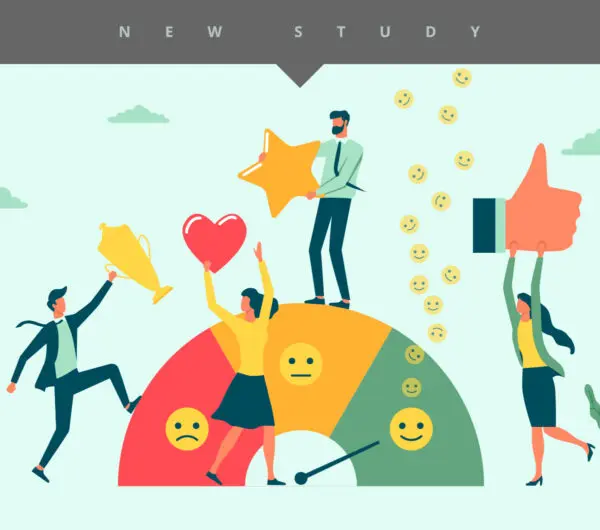
HR AI: New Study Reveals AI’s Potential for the Employee Experience
A recent bswift-commissioned Forrester study reveals that AI isn’t just another fleeting trend in the HR landscape – it’s a catalyst for change.
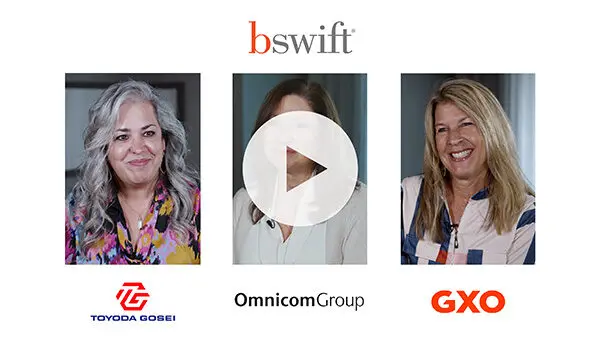
Flexible and User-Friendly: bswift Benefits Enrollment Solutions
Learn how bswift’s benefits administration platform streamlines HR’s work with flexible technology, seamless customization, and user-friendly tools to deliver benefits the way they’re meant to be.

Boost Operational Efficiency
Streamlining your teams’ workload is more important than ever. We simplify processes and make it easier for HR teams with human-focused HR solutions. Our flexible benefits administration platform seamlessly integrates with your current environment, saving time, reducing costs and minimizing risk.

AI for HR: 4 Key Trends You Need to Know Now
Cut through the hype. From Mindful AI to people analytics, these 4 trends in AI for HR boost employee engagement and attract top talent.
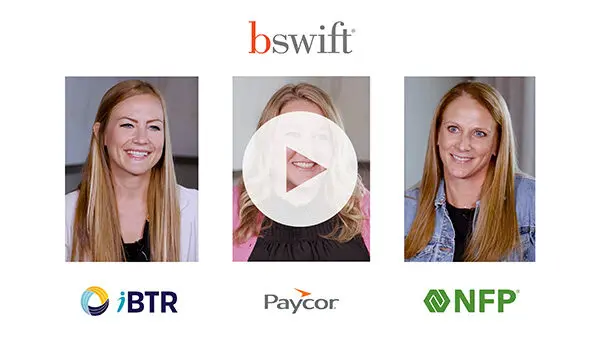
Ditch the Stress: How bswift Makes Benefits Administration Easy
bswift’s innovative platform takes the hassle out of benefits administration. See how we empower HR with user-friendly tools to help deliver benefits.

Streamline Benefits Administration
Take difficult high-touch tasks like retirement administration, HSA, billing, and compliance and let bswift handle them for you. Our innovative technology and benefits expertise streamline administration and enable you to focus on your people.

bswift Delivers a Stellar Annual Enrollment
Stress-free annual enrollment starts with bswift. Explore our infographic for HR tech, stellar service, and employee satisfaction at light speed!
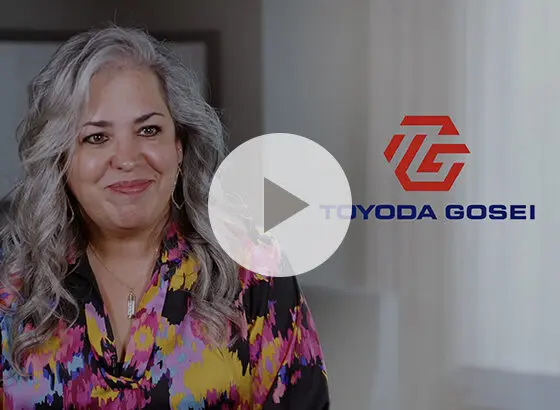
Toyoda Gosei Customer Story
Hear how bswift’s benefits tech stands out for its robust functionality, flexibility and dependability in managing complex benefits for a diverse workforce.

Strengthen Internal Communications
Effective communication is key to engaging employees. The bswift Engagement Agency designs strategies to improve how employees engage with their organizations. Using personalization tools that meet employees where they are, we ensure they are well-informed on the latest at your organization, whether it’s their benefits and annual enrollment, or other internal initiatives.

Solving the Employee Communication Puzzle: Tips for Better Engagement
Effective employee communication is crucial for HR. Learn best practices to improve benefits utilization and employee engagement.

The Winning AE Trifecta: AI, Employee Comms and Human Connection
In this webcast, bswift will explore how HR can optimize annual enrollment (AE). They’ll cover marketing-inspired communication techniques, the role of AI in streamlining HR processes and the importance of the human touch.
All Your Benefits Goals. One Flexible Ben Admin Partner.
Build a better benefits experience and earn employees’ trust. Our integrated and easily configurable benefits solution—designed for your needs.
Explore Our SolutionThe bswift Benefits Ecosystem
Streamlined HR Administration
Innovative administrative HR solutions that leverage advanced technology, efficient processes, and proven expertise to help your organization thrive.
Emma: Support Across the Benefits Journey
Emma™, powered by bswift’s Mindful AI, delivers human-like support throughout the benefits journey, adapting to your employees' needs from start to finish.
Defining Service Excellence
People-first benefits need a personal touch. With decades of experience and tech-enabled service, we empower your people, your business, and your community.
Personalized Employee Engagement
Boost employee health and wellbeing with our intuitive employee engagement solutions. Personalized processes maximize their benefit utilization.
Meet Emma
bswift uses Emma to provide personalized support. Emma is powered by Mindful AI™, which blends human sensitivity with advanced intelligence to ensure every interaction is both empathetic and effective.
Emma EnrollPro™ is an intelligent and personalized guide to simplify benefits selection for employees.
Emma Chat is like speaking to a top-tier support expert – anywhere and anytime.
Emma Agent Assistant analyzes call and chat dialogue in real time, offering tailored guidance based on plan details.
Clients that Trust in bswift
“A few words to describe the bswift technology: Flexible, customizable, user-friendly. Their ability to customize solutions for our complex organization really made a difference for us. I’ve truly enjoyed the partnership with them.”
-VP of Health and Welfare, Omnicom Group
bswift by the Numbers
bswift invests in people and technology to create better experiences for all of those we serve.
View our Mission
lives covered and experiences enhanced with bswift

Customer Service Transformation Award

Technology Excellence Award for Best Advance in Benefits Administration

Of clients retained due to our dedication to innovation and service
What's New

Hospital Benefits Administration: Simplify Healthcare Workforce Benefits and Contain Costs
Managing HR for a hospital is not your typical 9-to-5 job. Hospital HR professionals operate in a 24/7 environment where the stakes are sometimes quite literally life and death, and your workforce is a dizzying mix of clinicians, administrators and support staff.

Is Your Benefits Software Helping or Hurting? The Truth about HRIS Modules vs. Benefits Platforms
HRIS vs benefits platform? There are hidden costs with certain benefits software. Get the guide to choosing the right HR tech partner.

Leveraging AI to make every experience simpler, smarter, and more human
When we started building what would become Emma Intelligence, our team kept circling one question: How do we make benefits feel less like doing taxes and more like talking to someone who actually gets it?

bswift Beacon Ep. 06: Leading HR and Culture During Open Enrollment with Natalie Atwood
Tune in to the latest episode of the bswift Beacon. Joel and Denise are joined by Amit Jain, COO of bswift, to discuss the challenges of annual enrollment and how HR teams can navigate this busy season.

Thriving Through Open Enrollment: Lessons from bswift’s Chief People Officer
It’s open enrollment season — HR’s annual enrollment Super Bowl, where strategy meets sheer endurance.

Mindful AI®: Our Philosophy for Responsible AI in Benefits
AI is everywhere in HR right now. Every conference, every panel, every software demo — it’s the headline act. And if you’re in charge of benefits, you’re already feeling the squeeze.

bswift Wins 2025 Aetna Workplace Well-being Award
See how leading benefits admin company bswift earned the 2025 Aetna Workplace Well-being Award for innovative and comprehensive employee wellness programs.

Why Millennials and Gen Z Tune Out and How Personalized Employee Benefits Communication Changes Everything
Personalization isn’t a perk to Millennials and Gen Z—it’s the default setting. They expect their benefits to work like all digital experiences: seamless, intuitive, and a step ahead of their needs.

bswift Beacon Episode 05: Climbing the Annual Enrollment Mountain with Amit Jain
Tune in to the latest episode of the bswift Beacon. Joel and Denise are joined by Amit Jain, COO of bswift, to discuss the challenges of annual enrollment and how HR teams can navigate this busy season.

Beyond Checkboxes: Annual Enrollment Strategies That Engage and Deliver
For HR, annual enrollment isn’t just another task—it’s a high-stakes, strategic opportunity to boost employee engagement, satisfaction and retention.

How to Navigate (and Win) Open Enrollment Season
Prepare for enrollment season with our open enrollment checklist! Discover tips, strategies, and a comprehensive checklist to streamline your planning and execution.

Legislative Update: What the One Big Beautiful Bill Act Means for Employers
On July 4, 2025, President Trump signed the One Big Beautiful Bill Act (OBBBA) into law.

Benefits Administration Solution Buyer’s Guide for HR Teams
Download this HR Buyer’s Guide to benefits administration solutions. Learn how to compare vendors, evaluate features, and build a business case with real ROI.

bswift Beacon Episode 04: HR AI and Emma Intelligence in Focus with Vinita Pilani
Joel and Denise are back with bswift Beacon, this time joined by bswift’s Senior VP of Product Engineering, Vinita Pilani, to discuss the evolution of HR tech.

Wellbeing, Rewired: Employee Benefits in 2025
Discover four strategies HR leaders can use rebuild clarity, foster connections, create meaningful growth opportunities and boost employee engagement.

bswift Engagement Agency Wins Gold—Three Years Running
For the third consecutive year, the bswift Engagement Agency has earned a prestigious Gold Hermes Creative Award—this time for its innovative benefits communication campaign with bswift client Iron Mountain.
How bswift’s Service Center Is Redefining Employee Benefits Support
Hear how bswift's Service Center blends HR tech and empathy to transform employee benefits support—driving a 95% satisfaction rate.

bswift Announces a Powerful New Strategic Alliance with Benifex
bswift LLC, a leading innovator in employee benefits technology and administration, today announced an exciting new partnership with Benifex®, expanding its alliance partner ecosystem into a global benefits delivery.
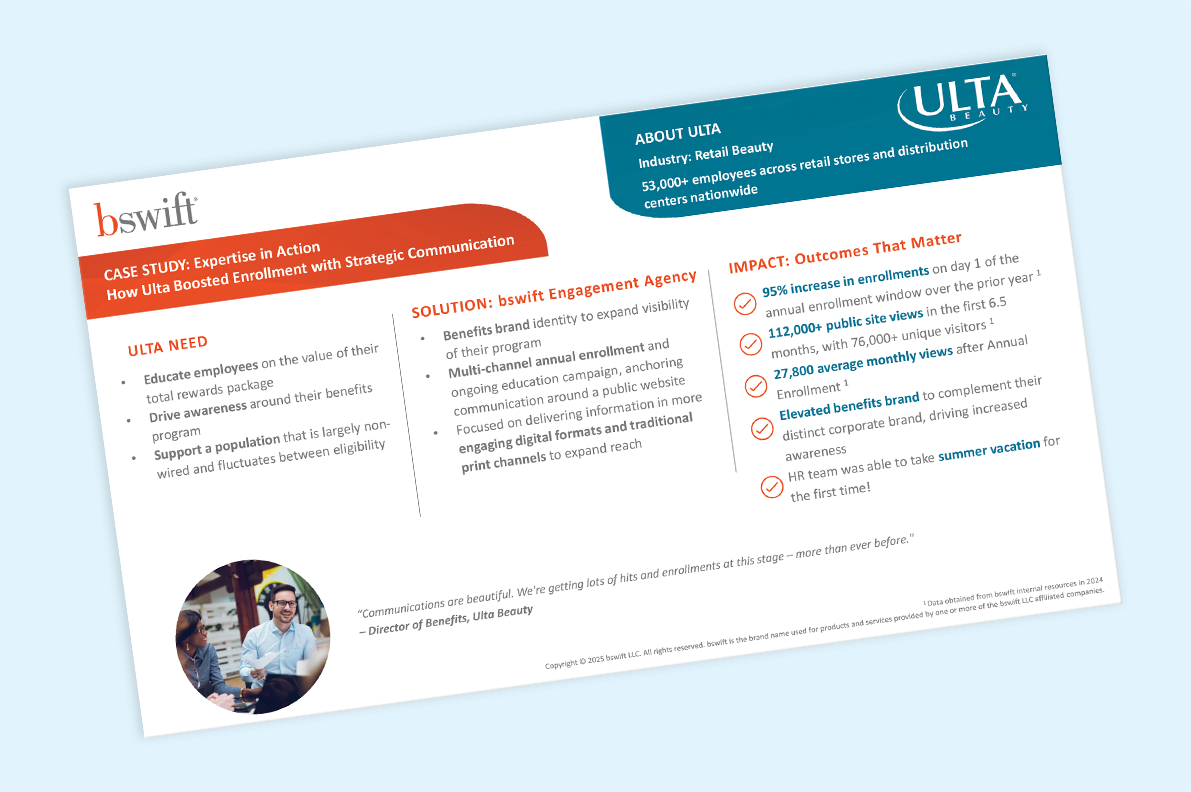
Benefits Engagement Strategy: Ulta’s Success Story
With 53,000+ employees across stores and distribution centers, Ulta needed a new approach to employee benefits communication—one that could reach a largely non-wired workforce. That’s where bswift’s Engagement Agency stepped in.

Next Gen HR: Recapping Ben Admin’s Bright Future at bswift’s Idea Exchange 2025
Relive the Idea Exchange 2025 highlights! Discover insights, standout sessions, and a recap of what made IX so incrediblen for HR pros this year.
bswift Beacon Episode 03: LIVE from Idea Exchange with Scott Millson on Leadership and Finding Your Frequency
Join hosts Denise and Joel for a special live episode of the bswift Beacon podcast, recorded at bswift’s Idea Exchange conference in Hollywood, FL.
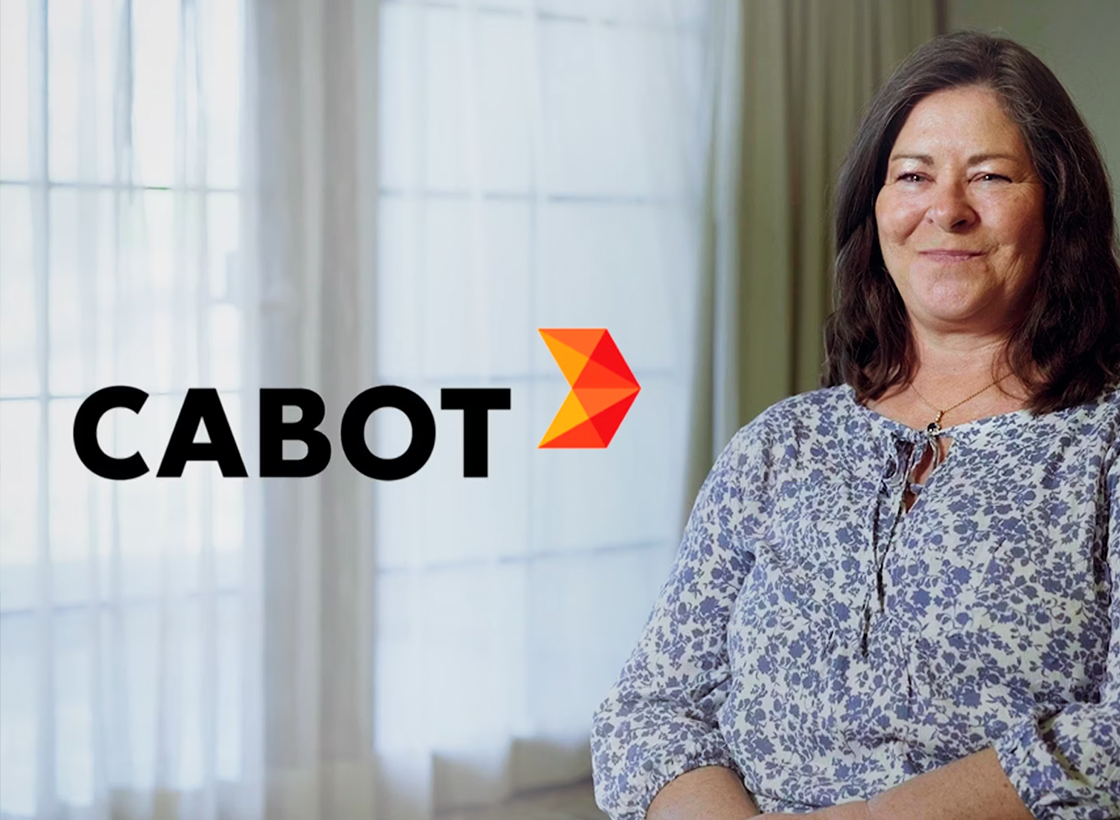
Streamlining Success: Cabot Corporation’s Partnership with bswift
Hear how bswift’s benefits administration partnership and intuitive solutions simplify enrollment, payroll, and data management while delivering exceptional support and empowering HR.

How MMA Delivers Big Results with bswift’s Powerful Benefits Platform
Learn why MMA partners with bswift to streamline benefits management, improve HR operations, and enhance the employee experience. With powerful HR tech, an experienced channel partner team, easy-to-use tools, and robust reporting features, bswift simplifies complex processes.

bswift unveils next-gen Emma Intelligence at its annual Idea Exchange conference
bswift LLC, a leading innovator in employee benefits technology and administration, announced the latest generation of Emma™, its intelligent, platform-level digital assistant.

Idea Exchange 2025: On-Demand General Sessions
Dive into some of the top sessions from Idea Exchange 2025—now available to watch anytime.
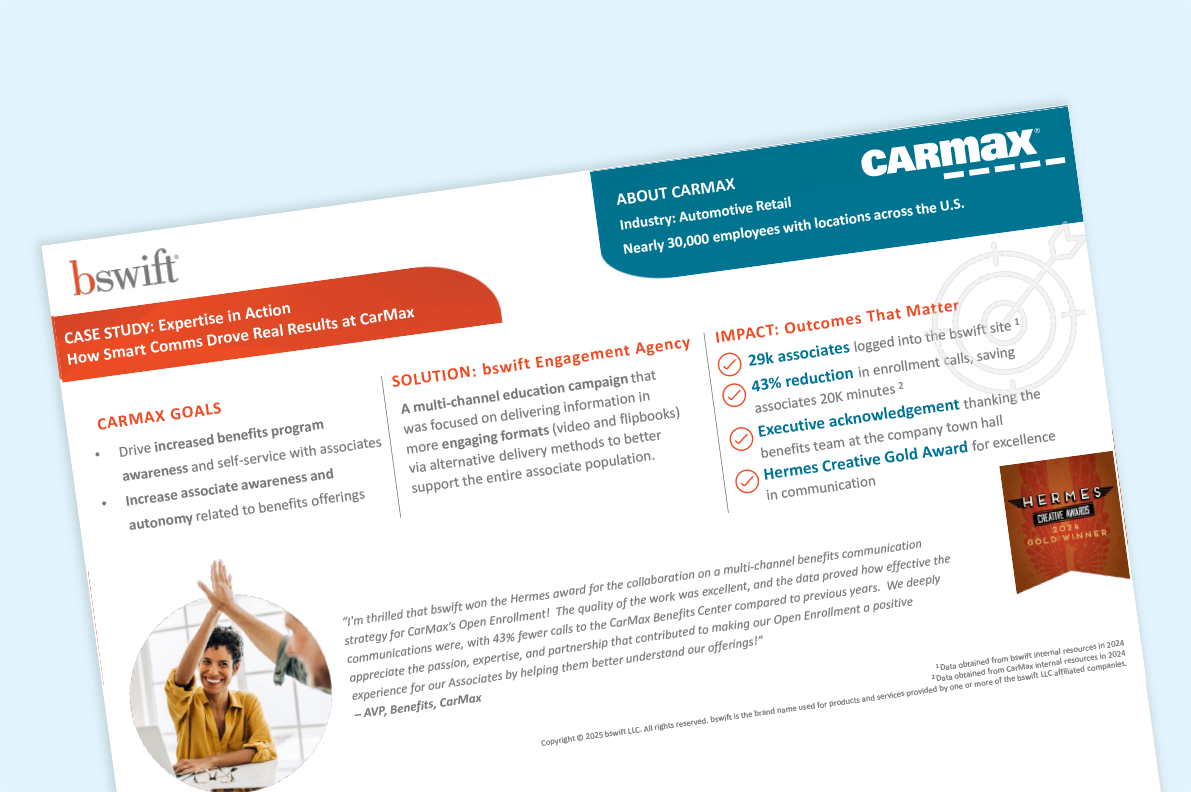
CarMax’s Success with Strategic Employee Benefits Communication
Through a tailored, multi-channel benefits strategy, bswift helped CarMax simplify complex benefits communication, drive associate action, and elevate the overall enrollment experience.
bswift Beacon Episode 02: The Future of Service Excellence with Eric Strom
Join hosts Denise and Joel for an insightful discussion with Senior Vice President of the bswift Service Center, Eric Strom, the driving force behind bswift’s Service Center transformation.
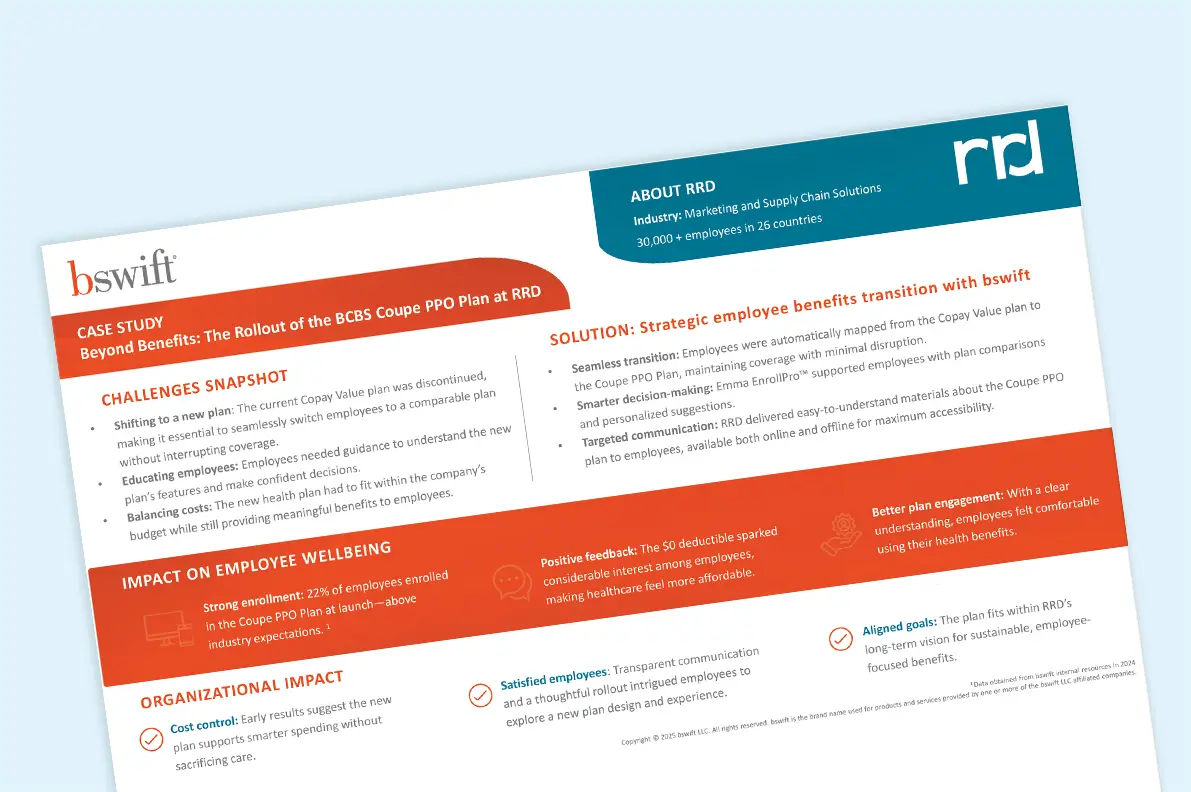
How RRD Simplified Employee Benefits Enrollment and Elevated Engagement
RRD partnered with bswift to streamline employee benefits enrollment, successfully managing a healthcare benefits transition while improving employee engagement. Learn how a strong benefits management strategy and clear communication plan helped RRD exceed industry benchmarks and drive better outcomes.
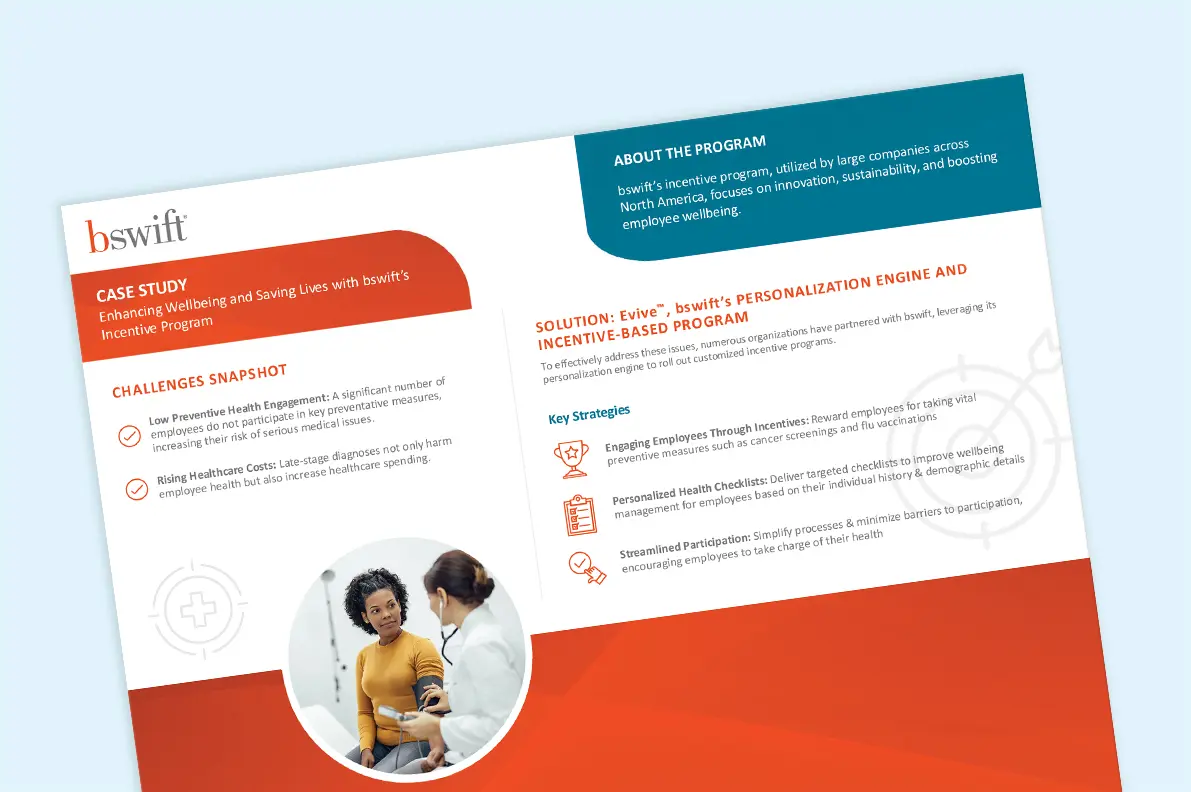
Enhancing Wellbeing with bswift’s Incentive Program
Discover how leading employers are using bswift’s incentive-based solution to drive preventive care, reduce healthcare costs, and boost employee wellbeing. With Evive™, employees are empowered to take meaningful health actions—improving outcomes for people and organizations alike.
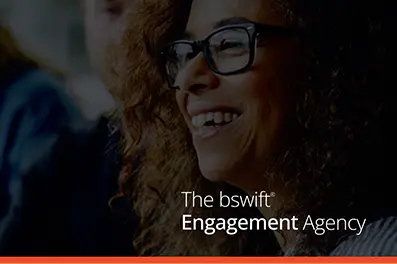
bswift Launches End-to-End Employee Engagement Ecosystem with the bswift Engagement Agency
The bswift Engagement Agency delivers a powerful mix of strategy, technology, and engagement.
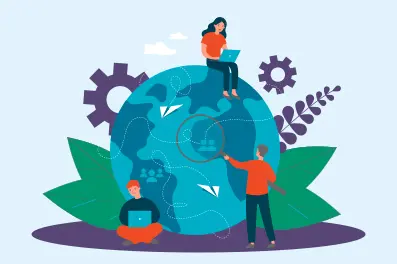
4 Steps to Build a Business Case for Better HR Tech Investment
Whether it’s clunky manual tasks, confused employees, low engagement, or compliance risks, your current system is frustrating and feels like it’s holding you back.

SHRM Webinar Replay: Solving the Employee Engagement Crisis
Employee engagement is not doing great. It’s at a 10-year low, with only 31% of U.S. employees reporting they feel engaged at work, according to Gallup. Disengaged teams don’t drive innovation, collaboration, or results for organizations.
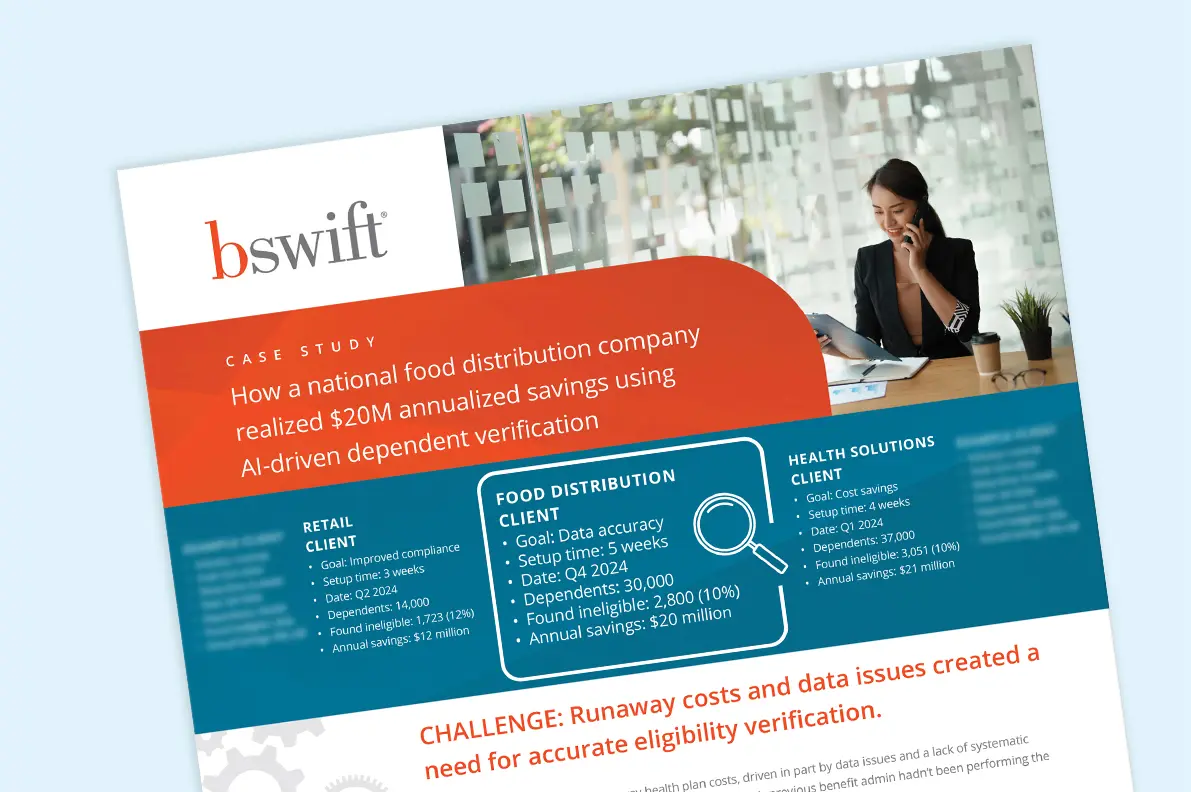
National Food Distributor Saves Millions with AI-Powered Dependent Verification
Discover how bswift deployed its AI-powered dependent verification audit in just two weeks to help a national food distributor save millions while significantly reducing manual work for the HR Team.
bswift Beacon Episode 01: Cracking the Code on Employee Engagement with Alyssa Zeff
Join hosts Joel and Denise for the debut episode of bswift Beacon. Get insights from internal communications expert Alyssa Zeff.
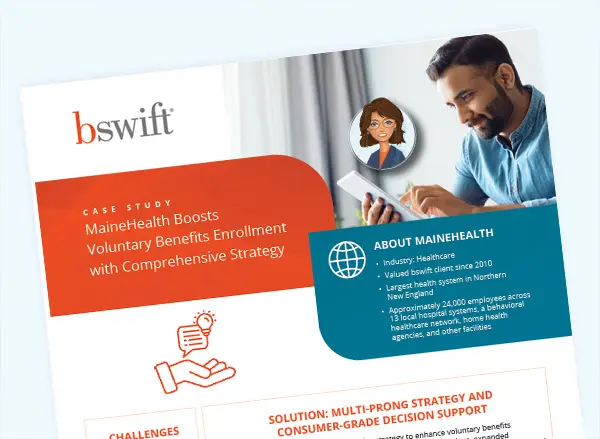
MaineHealth Boosts Voluntary Benefits Enrollment with Comprehensive Strategy
Discover how MaineHealth boosted voluntary benefits enrollment by updating carriers, enhancing plan designs, expanding communications, and using bswift’s Emma for personalized guidance.
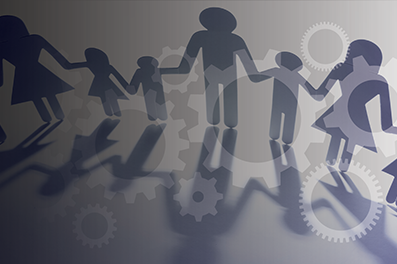
bswift Launches AI-Driven Dependent Verification: Unlock Savings and Ensure Benefits Equity
bswift LLC, a leading innovator in employee benefits technology and administration, is excited to announce the release of its dependent verification solution to all employers, regardless of whether they are an existing bswift benefits administration customer.

The Employee Engagement Crisis: 4 Ways HR Leaders Can Improve Morale and Productivity
Discover four strategies HR leaders can use rebuild clarity, foster connections, create meaningful growth opportunities and boost employee engagement.

HR Trends That Will Define 2025: Rising Costs, Smarter Benefits Strategies
Discover the HR trends shaping 2025, from skyrocketing healthcare costs to smarter benefits strategies. Learn how to stay ahead and support your team.

bswift Wins Gold in Brandon Hall Group’s Excellence in Technology Awards for the Fourth Consecutive Year
bswift’s approach combines advanced technology with a deep understanding of client needs, enabling seamless benefits management while fostering higher employee engagement.

bswift Delivers a Stellar Annual Enrollment
Stress-free annual enrollment starts with bswift. Explore our infographic for HR tech, stellar service, and employee satisfaction at light speed!

bswift Acquires Evive: Launches Integrated, Personalized Engagement Engine
bswift announces a fully integrated personalized engagement solution aimed at delivering better health care outcomes through data-driven personalization, predictive analytics, and behavioral science.

The Rising Impact of Diabetes on Workplace Productivity and Employee Health
Support employee health and reduce costs with effective diabetes management programs that promote workplace wellness and enhance productivity.
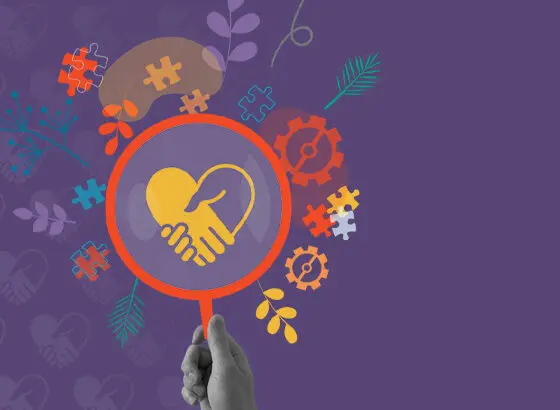
Values in Action: How Company Culture Drives Business Success
Here's how strong company culture, driven by core values, improves employee engagement and business success. Learn how to strengthen culture.
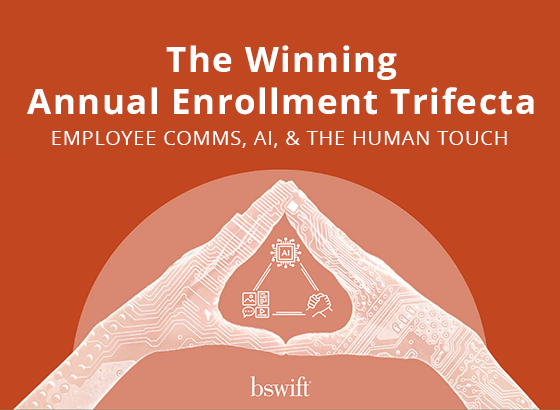
The Winning Annual Enrollment Trifecta
Our annual enrollment infographic unlocks the power of effective communication, AI, and human expertise for a seamless benefits experience.

AI for Health Plan Administration: 3 Ways It’s Transforming Benefits Management
AI is transforming benefits administration. Discover how bswift's Mindful AI® enhances human abilities, improving efficiency, accuracy, and user satisfaction.

HR AI: New Study Reveals AI’s Potential for the Employee Experience
A recent bswift-commissioned Forrester study reveals that AI isn’t just another fleeting trend in the HR landscape – it’s a catalyst for change.

Emma Chat: Supercharging Benefits Support
Navigating employee benefits can be complex, both for employees and HR teams. We’re excited to unveil the latest evolution of Emma™ Chat from bswift®, now enhanced with the power of Mindful AI™.

The Winning AE Trifecta: AI, Employee Comms and Human Connection
In this webcast, bswift will explore how HR can optimize annual enrollment (AE). They’ll cover marketing-inspired communication techniques, the role of AI in streamlining HR processes, and the importance of the human touch.

Conquer Annual Enrollment: 7 Steps to Scale Your HR Everest
Master annual enrollment with our checklist. From HR tech to communication planning, streamline your HR process and improve your employee benefits rollout.

Emma EnrollPro: AI-Powered Benefits Enrollment Made Easy
With bswift’s enhanced AI-powered Emma EnrollPro, HR can ensure a smoother benefits selection experience for their workforce.

bWise – Ep 30: Emma™ Asks the Experts: The Future of AI in Benefits Administration
Join hosts Don and Sharon as they explore the latest AI enhancements to bswift’s groundbreaking AI-powered platform intelligence, Emma.

4 Holistic Health Trends to Boost Employee Wellbeing and ROI
Learn how holistic health trends in employee wellbeing programs like value-based care, whole person care, mental health can boost ROI.
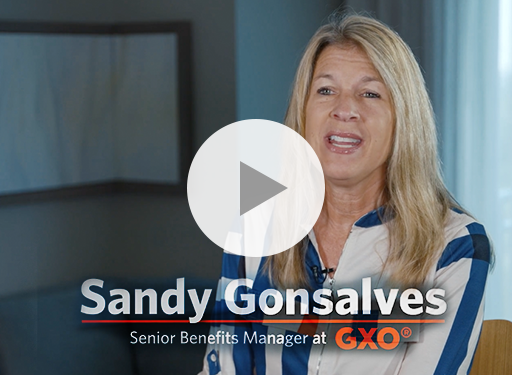
Flexible, Powerful, Trusted: bswift Redefines Benefits Admin
Hear why HR pros choose bswift for benefits administration. See why organizations of all sizes trust bswift to deliver efficiency, flexibility, and advanced functionality in benefits tech.

AI for HR: 4 Key Trends You Need to Know Now
Cut through the hype. From Mindful AI to people analytics, these 4 trends in AI for HR boost employee engagement and attract top talent.

Harnessing the Power of AI for HR
Unlock AI’s potential in HR with bswift: Automate tasks, enhance decision-making, and focus on strategic goals. Discover AI’s role in recruitment, onboarding, and more

bWise – Ep 29: Building the Future of HR with AI: A Chat with Jeff Kirk
Get practical insights for driving successful digital transformations across industries. Listen in as Jeff Kirk shares his 20+ years of experience and wisdom, with real-world examples of digitizing businesses

Employee Healthcare Cost Containment Strategies: A Guide for HR
Rising healthcare costs got your HR team down? Discover 4 data-driven cost-containment strategies from bswift's IX to reduce healthcare spending & improve wellbeing.

Harnessing the Power of AI for HR – Make it Mindful
Leverage AI for HR with bswift's Mindful AI® approach. See how AI enhances human expertise, recruiting, onboarding, engagement and compliance.

The Gold Standard in Employee Comms: bswift Communication Agency
bswift Communication Agency wins 2 Gold Hermes Awards for creative employee benefits communication. Learn more about our award-winning work!

Introducing the AI Supercharged Emma™: Your Employee Benefits Guide
Empower your employees with bswift's Emma, an AI-powered benefits assistant. Personalized recommendations, plan comparisons and more.

bswift’s Emma™ Agent Assistant Transforms Employee Benefits Administration with AI and the Human Touch
More than just an app, it’s a comprehensive wellbeing solution tailored for both employees and employers, simplifying the health journey.
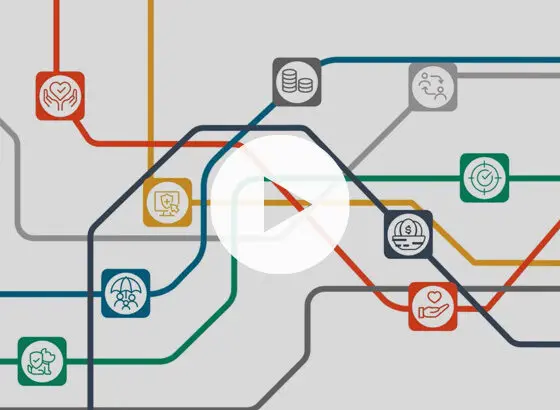
Simplify Benefits, Unlock HR’s Potential: bswift Has You Covered
Simplify benefits administration and empower HR with tools to streamline enrollment, optimize benefits use, and free HR for strategic work.

Solving the Employee Communication Puzzle: Tips for Better Engagement
Effective employee communication is crucial for HR. Learn best practices to improve benefits utilization and employee engagement.

bswift acquires Davis & Company, expanding its Communication Agency suite of solutions
Davis & Company will join our Communication Agency and grow its core offering to provide comprehensive solutions for all internal and HR communication needs.
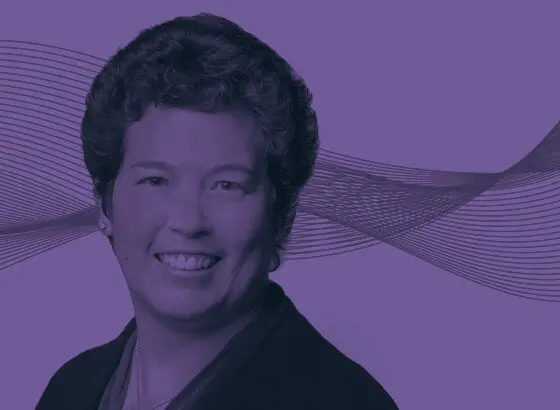
bWise – Ep 27: Streamlining Benefits Admin: Real-World Wisdom from Industry Vet Maria Yao
The latest episode of the bwise Podcast is a masterclass in optimizing operations. Tune in for Maria’s straight-shooting advice and elevate your operational capabilities.

Flexible and User-Friendly: bswift Benefits Enrollment Solutions
Learn how bswift’s benefits administration platform streamlines HR’s work with flexible technology, seamless customization, and user-friendly tools to deliver benefits the way they’re meant to be.

Ditch the Stress: How bswift Makes Benefits Administration Easy
bswift’s innovative platform takes the hassle out of benefits administration. See how we empower HR with user-friendly tools to help deliver benefits.

bWise – Ep 26: Achieving Liftoff: Lana Hillebrand’s Journey From Astronaut Aspirations to HR Industry Leader
In this episode, hosts Don and Sharon sit down with HR and benefits administration leader Lana Hillebrand, who recently joined bswift’s advisory council.

Optimize Benefits Enrollment: HR Best Practices for the ‘So-Called’ Off-Season
Benefits enrollment best practices for HR. Improve employee communications strategies, analyze benefits utilization and enhance benefits portfolios.

bWise – Ep 25: Navigating the Future of Ben Admin: A Conversation With Scott Millson
On this episode, benefit administration insider Scott Millson shares his unique perspective on his over three decades in the employee benefits field.

American Heart Month: How to Support the Heart Health of Your Workforce
February is American Heart Month – the perfect time to focus on workplace wellness and heart health through personalized digital tools and connected capabilities.

Choosing Your Benefits with Ask Emma
Choosing Your Benefits with Ask Emma Video Transcript

The Future of HR: 4 Trends Reshaping Employee Benefits in 2024
Let's look at the future of HR, from AI and automation to cost containment, tailored well-being initiatives, and adapting to remote work.

bWise – Ep 24: Ice Baths to Client Service Excellence: A Conversation With bswift COO Amit Jain
Listen in as bswift Chief Operating Officer Amit Jain talks about his passion for client service, his unique approach to leadership, and his vision for the future of benefits administration technology.
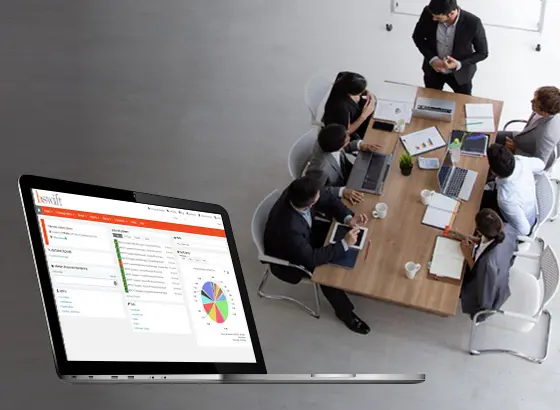
bswift Simplify: Streamlined Benefits Management for Channel Partners, NFP Signs On to Deploy
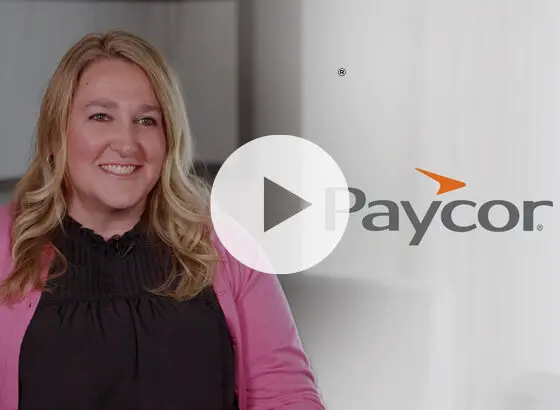
Paycor Channel Partner Story
Learn how the expertise, seamless integration, and customer-focused approach of benefits admin platform bswift supports Paycor. Watch Video.
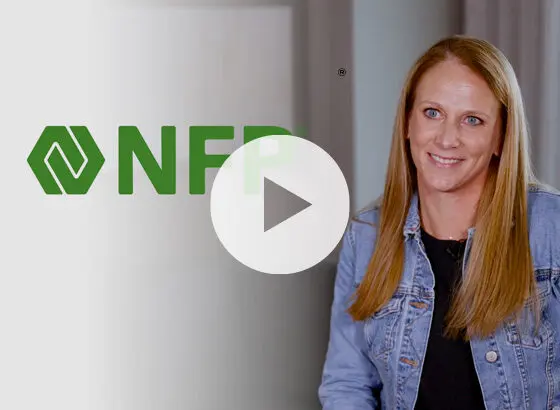
NFP Channel Partner Story
bswift combines technology, flexibility, and support to meet NFP's diverse client needs with a user-friendly interface and exceptional client collaboration.

bswift Wins Third Consecutive Brandon Hall Group Award for Benefits Administration
With the consistent recognition by Brandon Hall Group, bswift continues to be a trailblazer in benefits administration technology and an indispensable ally in enabling people-first benefits success.
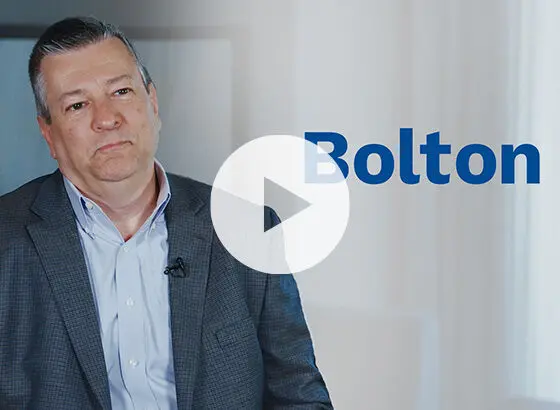
Bolton Channel Partner Story
Bolton partners with bswift for an intuitive, user-friendly benefits platform and exceptional support. Watch video now.

Transform Benefits Engagement With bswift’s Next-Gen Mobile App
Manage benefits effortlessly with bswift Mobile. This secure, intuitive app offers biometric login, on-the-go healthcare access, and simplified benefits navigation.

How to Improve Employee Benefits Engagement
Boost employee benefits engagement with proven HR strategies like clear communication, feedback loops, and AI chatbots to empower employees

Reduce Barriers to Care: bswift Enables Same-Day Pharmacy Benefits
Get prescription benefits instantly with bswift's real-time integration. Enjoy day-one activation, improved care access, and a stronger employer value proposition.

bWise – Ep 23: Shaping Culture and Service: A People-First Approach to HR with bswift’s Natalie Atwood
bswift’s Chief People Officer Natalie Atwood talks with bWise hosts Don and Sharon about her passion for putting people first.

bswift Elevate™: Empowering Holistic Employee Wellbeing, Anywhere and Anytime
bswift Elevate is reimagining the employee well-being journey and simplifying the employee experience with hyper-personalized messaging to drive deeper engagement in employer wellbeing programs.

Boost Benefits Utilization with bswift’s New Personalized Employee Wellbeing Solution
More than just an app, it’s a comprehensive wellbeing solution tailored for both employees and employers, simplifying the health journey.
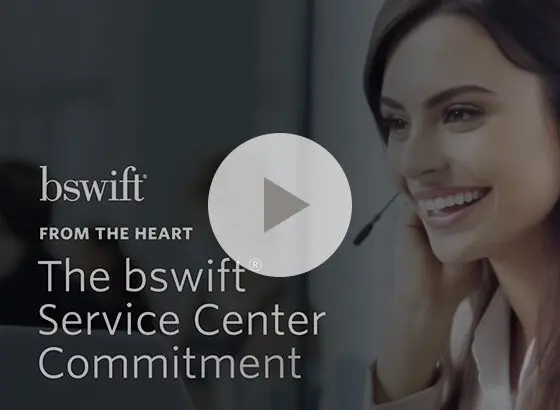
The bswift Service Center Commitment Video
Benefits can be difficult to understand. Watch this video to see how bswift's Service Center makes it simpler for employees.

Want Engaged Employees? Show Full Value with Total Compensation Statements
A smart way to boost employee engagement is to create a total compensation statement that details the value of their salary, benefits and other rewards.
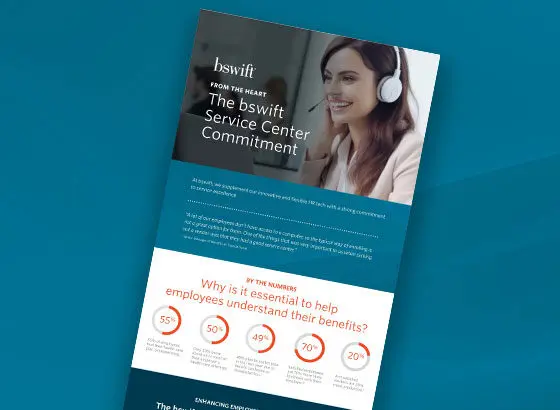
The bswift Service Center Commitment
At bswift, we supplement our innovative and flexible HR tech with a strong commitment to service excellence.

Toyoda Gosei Customer Story
Hear how bswift’s benefits tech stands out for its robust functionality, flexibility and dependability in managing complex benefits for a diverse workforce.
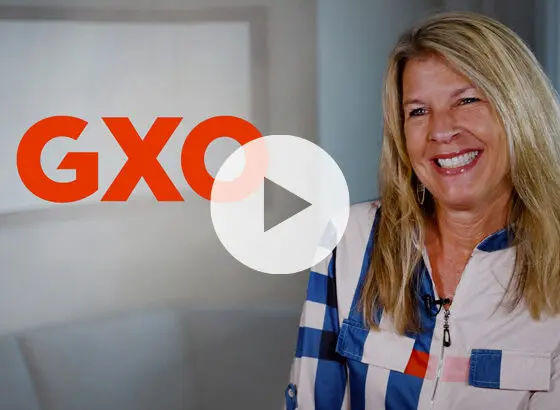
GXO Customer Story
See how bswift’s flexible solutions and services helped GXO quadruple their benefits enrollment rate. Watch Video here.
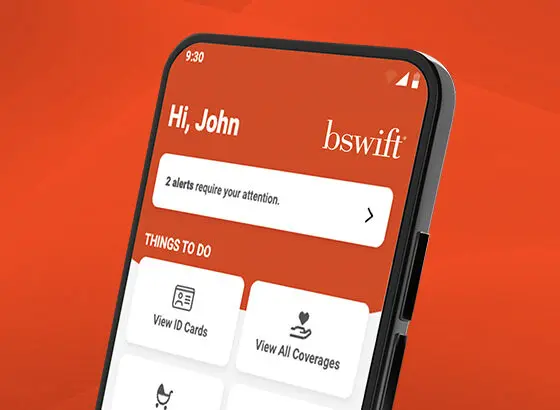
bswift Mobile App: Empower Your Employees
The bswift Mobile App offers your employees seamless access to their benefits. Download the app now via the App Store or Google Play Store.
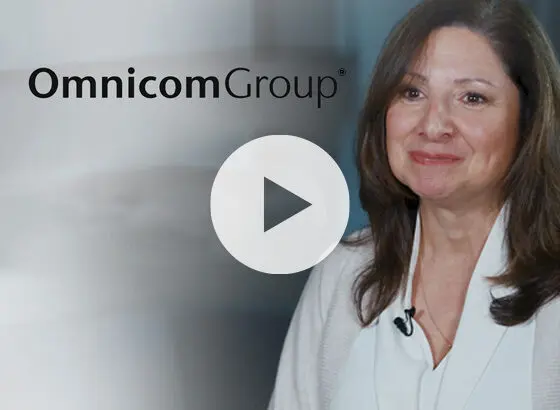
Omnicom Group Customer Story
See how bswift’s flexible solutions and services helped Omnicom navigate their complex benefits administration needs. Watch now!
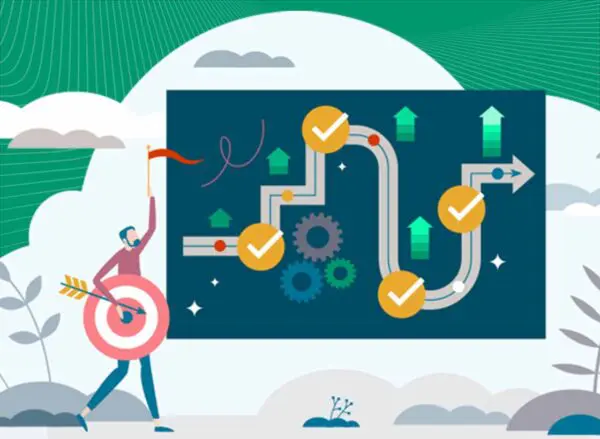
Ace Annual Enrollment: 4 Solutions to Common HR Challenges
Make annual enrollment frictionless and empowering, These tips will help you optimize the employee experience and drive talent retention.

Unlocking the Power of Employee Benefits
Discover the hidden keys unlocking the full value of your benefits program for your employees and your organization. Watch it now!

Prioritizing Employee Wellbeing for Business Success
Explore the core connection between employee benefits, employee wellbeing, and business success. Get a roadmap for reviewing your organization's current offerings to ensure they're relevant, accessible and effectively supporting workforce health and productivity.

Welcoming Industry Powerhouse Sue Thomson as bswift’s new Chief Growth Officer
In her role as CGO, Thomson will oversee sales, client success, marketing, and growth strategy focused on expanding bswift’s market share.
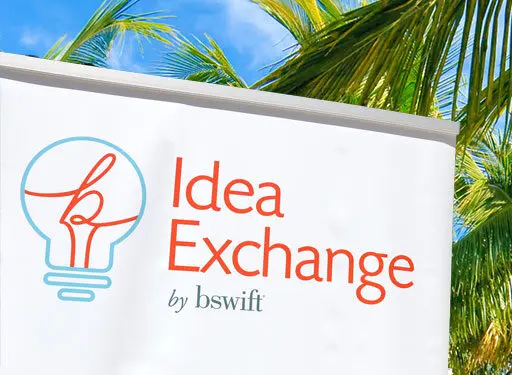
Insights and Highlights: A Recap of bswift’s Idea Exchange 2023 Conference
bswift's Idea Exchange 2023 Conference brings you insights on employee benefits engagement and benefits administration. Access session videos and more. Perfect for any HR professional looking to stay up-to-date.

bWise – Ep 20: Digital Transformation: HR and Employee Engagement, With NFP’s Mark Rieder
In this episode, we’ll explore how digital transformation can improve the employee experience, boost customer satisfaction, increase productivity, and drive greater profitability for the company.
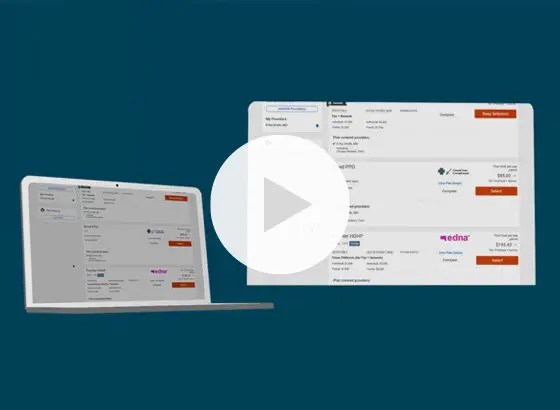
Fueling Outcomes: bswift’s Innovation Strategy and Latest Enhancements
Watch bswift's latest video to get up to date on bswift's latest innovation strategy and enhancements. Watch video now.

bWise – Ep 22: Driving Operational Excellence at bswift With Adam Hostetter
Get an insider’s look at how bswift’s Head of Operational Excellence, Adam Hostetter, is driving major improvements. Learn how his team is enhancing service delivery, upgrading technology, and aligning workstreams to accelerate growth.

Hire Emma: bswift’s AI HR Assistant That Pays for Herself
Meet Emma, the AI HR assistant who resolves benefits questions, provides enrollment guidance, and improves the employee experience.

bWise – Ep 21: bswift’s Bright Future, Mission, and Passion, With bswift CEO Ted Bloomberg
In this episode, you’ll learn more about bswift’s leadership, what fuels our passion for our clients and partners, and our commitment to deliver excellent technology and service to all those we serve.

Here’s How to Create An Engaging Employee Benefits Communication Strategy
Great employee benefits communication is crucial for employee satisfaction. Get tips for effective benefits communications that engage all stakeholders, using a multi-channel approach, incorporating empathy, focusing on timing, highlighting total rewards, and broadening the conversation on employee wellbeing.
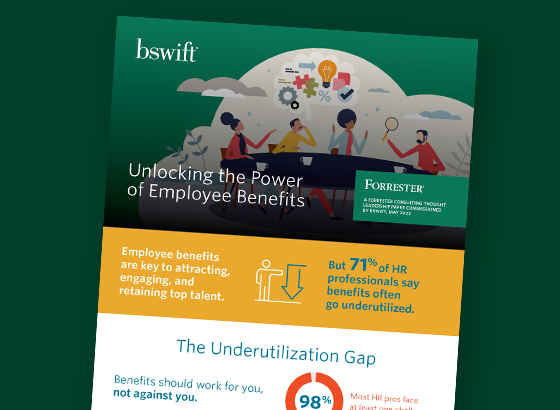
Unlocking the Power of Employee Benefits
Employee benefits are key to attracting, engaging and retaining top talent. Read this infographic to learn more on the underutilization gap

The Power of Effective Employee Benefits Utilization: Tips to Boost Benefits Engagement and Retention
Improve retention, engagement, wellbeing and productivity with an effective employee benefits utilization strategy. Boost benefits engagement with these tips.

Welcoming Amit Jain, bswift’s new Chief Operating Officer
Jain will lead bswift’s Client Services, Service Center, and Channel Partner Operations, as well as the Operational Center of Excellence.

Maximizing Employee Benefits Utilization: Challenges and Solutions
Improve engagement and retention with effective employee benefits utilization. Learn common challenges, solutions, and the importance of prioritizing employee wellbeing.

bswift Expands Strategic Partnership Program to Simplify HR and Optimize Benefits Offerings
bswift is expanding its Strategic Partnership Program, an innovative solution that simplifies how employers integrate their benefits ecosystems, centralize programs, and optimize offerings to empower employees and boost benefits utilization.

Forrester Research Reveals the High Cost of Low Employee Benefits Engagement (And What You Can Do About It)
Discover how HR pros can improve employee benefits engagement with insights from Forrester Research. Boost morale, productivity and retention, and cut healthcare costs. See the survey results and actionable strategies now.

bswift Communication Agency Wins Two 2023 Hermes Creative Awards
bswift, a leading provider of benefits administration and technology solutions, has received prestigious recognition for its exceptional creativity and innovation in employee benefits communication.

The Top 5 Employee Benefits to Boost Satisfaction, Retention and Recruitment
Learn which employee benefits matter most to employees, and how these top employee benefits boost satisfaction, retention, and recruitment. A must-read for HR professionals.
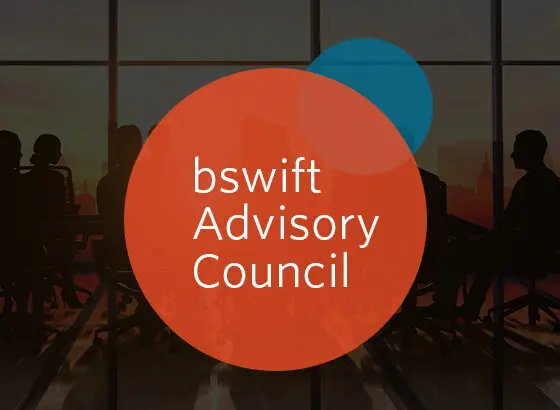
bswift Forms Strategic Advisory Council
bswift has recently announced the formation of an Advisory Council comprised of some of the industry’s most insightful and experienced professionals.

How to Use AI to Improve HR: bswift Experts Answer CHROs’ Most Pressing Questions
bswift experts answer CHROs' questions about using AI to improve HR. Learn how to avoid pitfalls, partner with CTOs, and create a better employee experience.

How to Successfully Implement AI in HR: The CTO and CHRO Partnership
Let's look at the benefits and the risks of AI in HR. From data privacy to legal liability, CHROs and CTOs can partner to safely implement AI for business.

Boost Benefits Utilization with a Great Employee Benefits Communication Plan
Unlock the full potential of your employee benefits communication. Benefits U helps you save time and effort and boost employee engagement.

Webinar: Ask the Experts – How to Make AI an Essential Workforce Tool
Artificial intelligence is set to revolutionize the way we manage workforces. Watch our webinar to take your AI knowledge to the next level

ACA Management Suite
Introducing ACA Management Suite, offering a suite of management solutions to help employers navigate the new world of healthcare and benefits

bswift at the Employee Health Care Conference – New York, 4/18-4/19
bswift will be at the Employee Health Care Conference in New York from April 18-19. Learn more about the upcoming conference.

Cut Costs, Not Benefits: Establish a Culture of Health in Your Workplace
Learn how to reduce healthcare costs and improve employee satisfaction with a culture of health in the workplace. Follow these 6 easy steps.

Celebrating Black History Month with Benefits Equity
How you can make the most of this celebration by incorporating employee benefits into your diversity, equity, and inclusion strategy.

bswift Enhances Ask Emma with AI to Deliver Personalized Benefits Recommendations and Personalized Employee Support
bswift has significantly upgraded, Ask Emma, its AI-powered decision support solution, to provide a hyper-personalized benefit recommendations and virtual support for employees.

6 Great Questions To Help You Measure Annual Enrollment Success
With the dust settling on annual enrollment, it's time to look back and learn. Here are a few simple questions you and your HR team can ask.

The Top 5 HR Trends of 2023: Leveraging Tech to Put the ‘Human’ Back in HR
In 2023, technology will continue to play a major role in how we adapt. Here are the top five HR trends we’re watching in 2023.

Welcoming Ted Bloomberg, bswift’s new Chief Executive Officer
Ted Bloomberg joins bswift as CEO, bringing 25 years of leadership experience to drive growth, innovation, and a new chapter for the benefits technology leader.

bswift a sponsor of TBGH’s 18th Annual Benefits Forum
bswift is looking forward to sponsoring the Texas Business Group on Health's 18th Annual Benefits Forum! Learn more and check out the agenda!
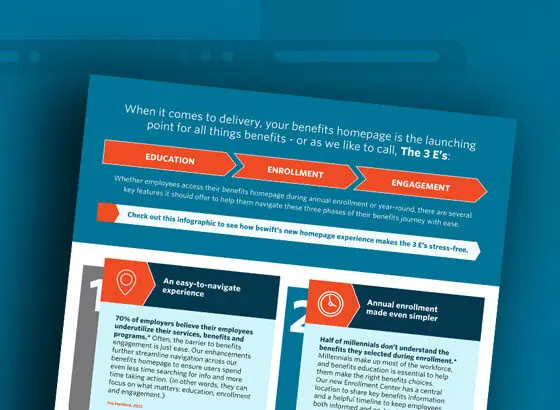
The 3 E’s and bswift’s New Homepage Experience
Your benefits homepage is the launching point for all things benefits, check out this infographic to see how bswift's new home page experience makes the 3 E's stress free.

Visit bswift at HLTH 2022 in Las Vegas from Nov. 13-16!
bswift is attending HLTH 2022 in Las Vegas from November 13-16th! Visit our booth and you could win a set of Apple AirPods or an Apple Watch!
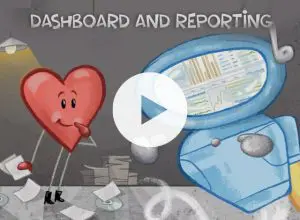
bswift Dashboard and Reporting
The bswift Dashboard and Reporting tool provides easy access to the robust data you need in customizable reports, all in one location.

The 2022 IBI/Conference Board Health and Productivity Forum
We’re excited to be apart of the IBI Conference Board Health and Productivity Forum. Our bswift sponsored pre-conference reception from is Sept. 27, 3-6 p.m. at the Marriott Marquis Chicago!

Solving the Great Resignation: The Role of Employee-centric Benefits, Tech & Culture
Struggling to navigate the Great Resignation? Here are a few ways to improve and develop a more employee-centric-culture.
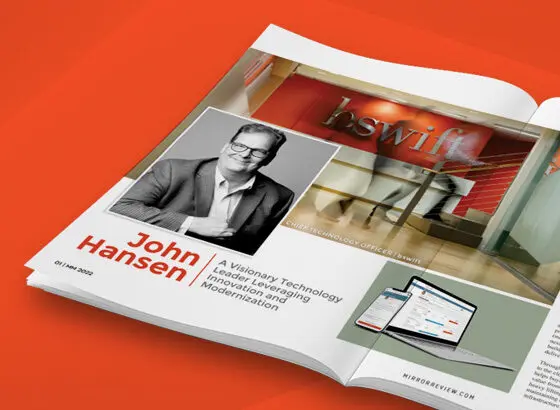
John Hansen, CTO, recognized in Mirror Review’s 10 Dominant Cloud Leaders of 2022
bswift's John Hansen, CTO, was recently recognized by Mirror Review magazine in their 10 Dominant Cloud Leaders of 2022. Read more!

bswift a proud sponsor of NEBGH’s 11th Annual Health & Wellness Benefits Conference
bswift is proud to be a sponsor of the Northeast Business Group on Health's upcoming Annual Health & Wellness Benefits Conference.

Introducing bswift Navigation Advocate, powered by Health Advocate
bswift is proud to offer leading concierge services via Health Advocate. Click to learn more.

Eric Hollenbach joins bswift as Consultant Relations Leader
We are excited to share that Eric Hollenbach has joined the bswift team as our Consultant Relations Leader!

Jim Rigdon named Senior Vice President of Sales at bswift
Jim brings 23 years of benefits administration expertise to bswift, driving revenue growth and client success. He's an MBA graduate with a strong healthcare background.

bswift receives Brandon Hall Group’s Gold Award for Best Advance in Benefits Administration

bswift interviewed by HRO Today: Delivering a Benefits Experience for the Whole Employee
HRO Today recently connected with bswift on how organizations are increasingly embracing benefits that support their employees.
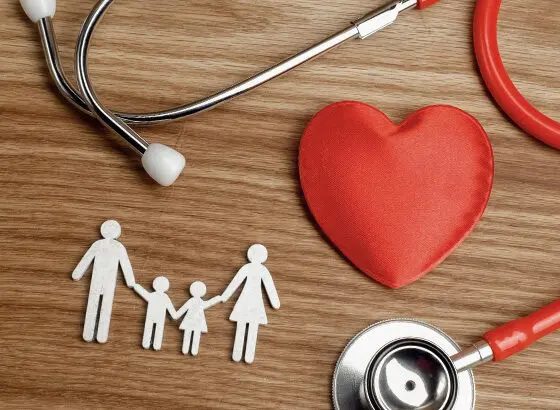
bswift interviewed by HRO Today: Empowering Employees Through Annual Enrollment and Beyond
HRO Today connected with bswift on how organizations are embracing new strategies to enable workforces to achieve their benefits goals

bswift launches COVID-19 Vaccine and Testing Confirmation Solution, bswift Attest
bswift clients and channel partners can contact their bswift representative to learn more about getting started with bswift Attest. Read more

We are bswift
From innovation and data security to compassion and care, hear from our people about what makes us bswift.
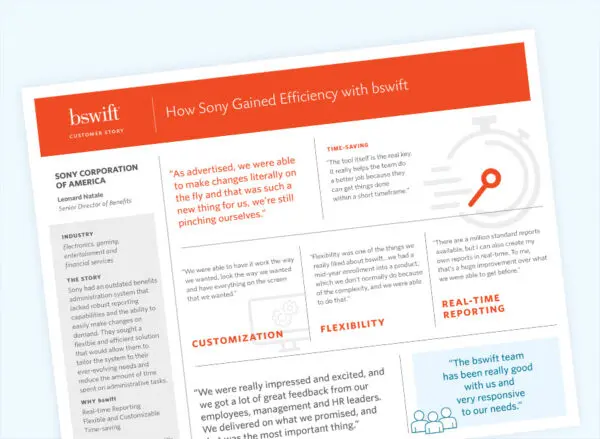
Sony Corporation of America Customer Story
Read how Sony gained efficiency with bswift.
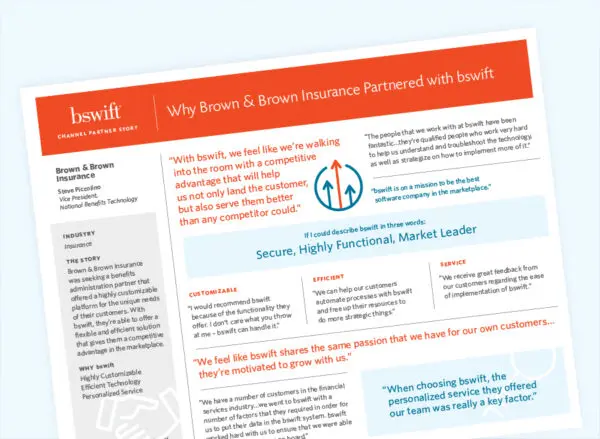
Brown & Brown Channel Partner Story
A bswift Channel Partner Story, on why Brown & Brown Insurance partnered with bswift
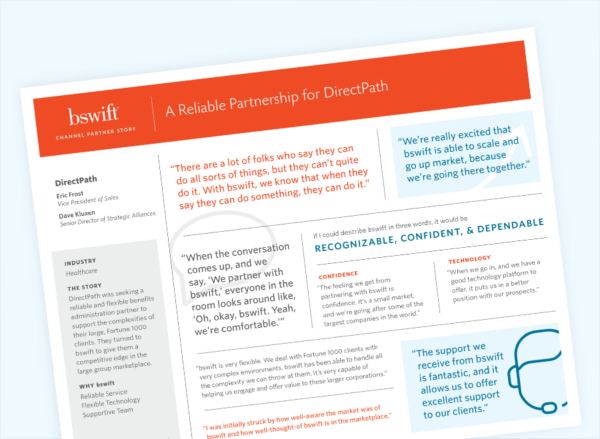
DirectPath Channel Partner Story
A reliable partner for DirectPath, "with bswift, we know that when they say they can do something, they can do it.”
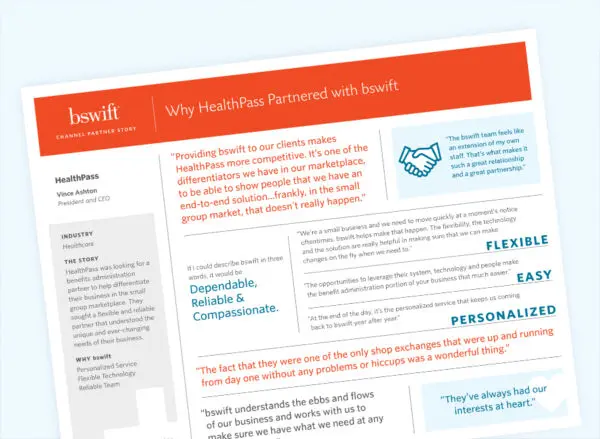
HealthPass Channel Partner Story
Explore why Channel Partner, HealthPass, partnered with bswift to enter the competitive healthcare benefits workspace.
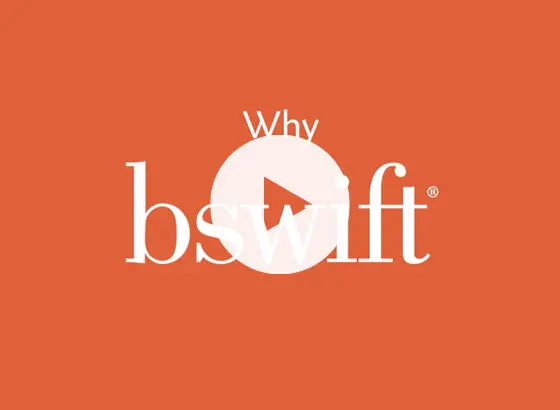
Partner Customer Story
Watch to see firsthand why enterprises across the country choose our bswift platform to transform benefits administration.

Sony Corporation of America Customer Story
Read how Sony gained efficiency with bswift.
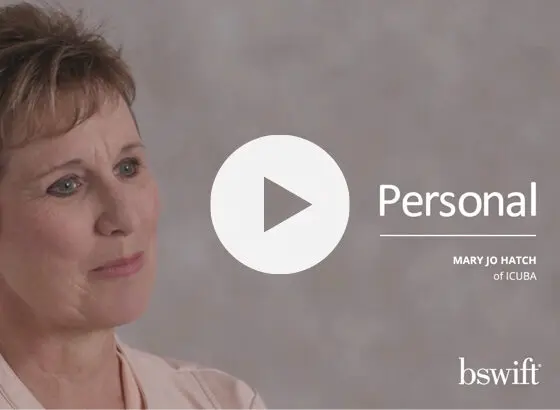
ICUBA Customer Story
Watch customer story now
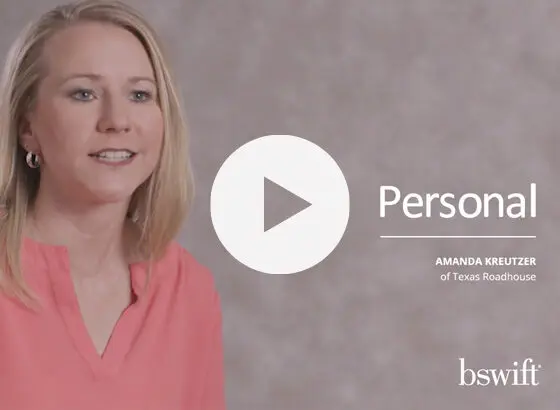
Texas Roadhouse Customer Story
Watch customer story now.
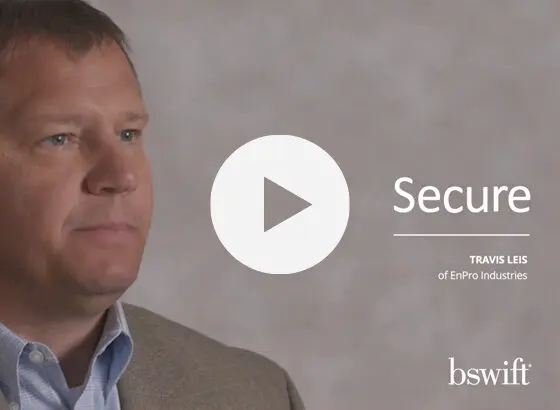
EnPro Industries Customer Story
Learn how EnPro Industries boosted enrollment with bswift.

JELD-WEN Customer Story
JELD-WEN praises bswift's comprehensive system for ease of enrollment, compliance support, and boosting high deductible plan enrollment by over 250%.
Experience bswift in Action
Experience the way benefits are meant to be. Speak with a bswift expert today or book a demo to see our industry-leading benefits administration and AI-powered HR solutions in action.
